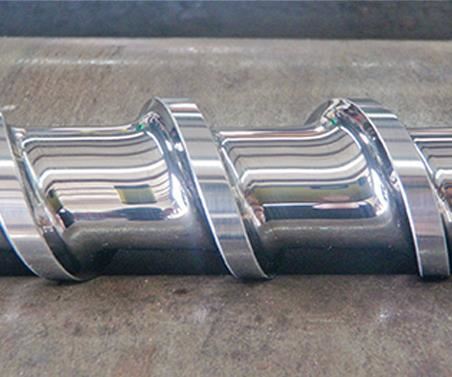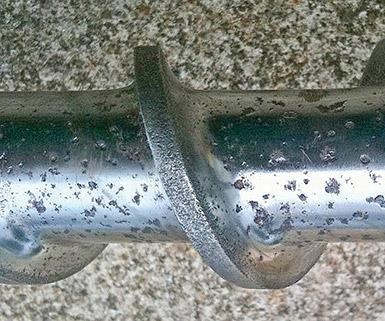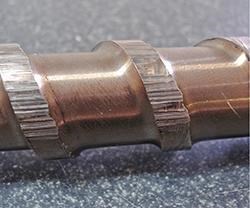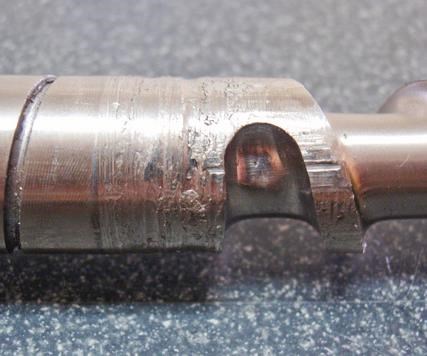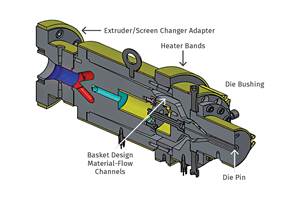How to Spec’ Screws & Barrels For Running Corrosive Materials
Tips & Techniques
Here’s a guide to specifying screws and barrels that will last under conditions that will chew up standard equipment.
Corrosive, abrasive, and high-temperature resins can degrade screws and barrels before you know it. Certain engineering materials, thermoplastic elastomers, plus the wave of newly developed biopolymers, often create a corrosive condition that can quickly degrade equipment. Reinforcements such as glass fibers, spheres, and other fillers and additives are abrasive and also take a toll on equipment, especially feedscrews and barrels.
Processors have to closely monitor the effects that their resins are having on the equipment to avoid production inefficiencies and potential part-quality problems. A preventive maintenance (PM) program that includes frequent inspection for corrosive and abrasive wear is required to maintain processing standards.
Screws and barrels should be examined, measured, and pulled for rebuilding or replacement when needed because even minimal wear affects production and threatens quality.
The best way to protect equipment against abrasive and corrosive resins is to select screws and barrels constructed of the right materials to protect against wear from the types of plastics to be processed. Wear-resistant barrels and screws manufactured to protect against abrasion, corrosion, and high-temperature melt processing cost more than the standard, polyolefin-grade variety—as much as three or four times more—because corrosion-resistant alloys are expensive and difficult to machine. But they provide better wear life and longer intervals between servicing.
ACIDS ATTACK SURFACES
Corrosive wear such as pitting on the surfaces of barrels and screws occurs when metal is attacked during processing by acids and acidic gases, which can dissolve oxide coatings. Highly corrosive polymers include PVC, which produces hydrochloric acid; acetals, which produce formic acid; and fluoropolymers, which produce hydrofluoric acid. Standard bimetallic, nitrided, or tool-steel barrels can be severely damaged by fluoropolymers in a very short time. Other corrosive melts are those containing flame retardants and foaming agents.
Resin manufacturers are generally happy to provide equipment recommendations for processing their products. DuPont makes it very clear that special corrosion-resistant materials must be used for all parts of extrusion equipment that come into contact with the melt when processing its Teflon fluoropolymers. The materials of choice are nickel-based alloys such as Hastelloy, Inconel, Monel, and Haynes, which are not affected by the acids.
DuPont also notes that hardened electroless-nickel plate can be used, but even small holes, chips, or cracks in the plating can degrade performance. Chrome-plated barrels and screws are not recommended for processing fluropolymers.
NatureWorks, manufacturer of Ingeo bioplastics, recommends use of stainless steel for all processing equipment to minimize corrosion, noting that PLA should not be left in the extruder, polymer filter, transfer lines, or other part of the extrusion system at melt temperatures for extended periods.
Corrosion-resistant materials have a lower coefficient of thermal expansion (CTE) than standard steel, which can cause trouble during processing high-temperature resins such as fluoropolymers. When the CTE of the barrel is different from that of the screw, the screw/barrel clearance changes, which can cause the screw to bind and damage the barrel. Matching the screw and barrel is important due to the lower thermal conductivity of corrosion-resistant materials. Screw and barrel manufacturers can provide expertise in pairing these components.
Abrasive wear, which is caused when gritty reinforcements and other hard particles scour the barrel and screw surfaces, can be combated by using hardened, wear-resistant alloys and coatings. Tungsten alloys for barrel linings and screw hardfacings offer excellent protection against abrasive wear.
Carbon content affects an alloy’s hardness. For screws, medium-carbon, heat-treated steel is typically used as a base on which hardfacings are welded to the tops of the flights.
Screws often are surfaced with hard cobalt- or nickel-based weldments or manufactured with tool steels that can be case-hardened or through-hardened. Colmonoy 56, a nickel-chrome-boron alloy, is often used to protect screws against mildly corrosive and mildly abrasive resins. Colmonoy 83 hardfacing offers more protection at a higher price.
Bimetallic barrel liners of abrasion-resistant alloys offer protection against various wear conditions and provide a range of cost/performance options. Among the best in terms of corrosion resistance are HIP (hot isostatic pressing) barrels for injection molding and extrusion. Even fluoropolymers are no threat to these barrels, which have a protective layer of nickel-rich boron alloy containing molybdenum and a matrix of borides and carbides.
When used with corrosion-resistant screws, HIP barrels are said to reduce substantially the absorption of iron particles from the barrel bore into the melted polymer. Of course, this degree of protection comes with a much higher price tag. Nickel-chrome and tungsten barrels can be used as long as the barrel discharge end is cast in Inconel and the surfaces of the transducer holes and flanges are made with Inconel as well. Those barrels can be bought for considerably less than HIP barrels.
PREVENTIVE MAINTENANCE
The penalties of excessive wear can be significant to the processor’s bottom line. Too much clearance between the screw flights and the surface of the barrel can affect the machine’s performance, efficiency, and energy consumption. In extrusion, wear conditions result in lower throughput, requiring an increase in screw speed and energy use. That is usually accompanied by higher melt temperature and resulting quality problems.
Careful monitoring of the critical screw/barrel clearance by means of a good PM program will ensure maximum processing throughput without unscheduled downtime. A PM program is equally important when part quality is critical, as when producing medical tubing and components for medical devices.
The screw should be pulled and thoroughly cleaned while still hot to check the flight OD and the barrel ID on a regular basis. Plastic materials on the surface of the screw and barrel can be removed with a wire brush and copper gauze. Precision wear measurement instruments, accurate and easy to use, are available in a variety of sizes and capabilities.
Once the barrel is purged of all plastic, an electronic bore gauge is inserted into the barrel, and readings are taken at every inch mark to generate data on the condition of the ID. The screw’s flight diameters and depths are measured using a flight micrometer. Digital versions provide LCD readouts and enable the data to be logged into a computer.
Taking those measurements on a regular basis to determine rate of wear will enable the operator to predict when the screw or barrel will need to be replaced or repaired and to schedule the downtime during a favorable time. The recommended clearance for a new 2-in. screw and barrel is 0.004 to 0.006 in.
A rule of thumb is one thousandth per inch per side. Screws should be rebuilt when they exceed the maximum clearance. Repair services can give renewed life to worn components at lower cost than complete replacement. Barrels for injection molding can be resleeved in the worn sections. Extruder barrels typically have to be resleeved along the whole length, which is more expensive and not always cost-effective.
Once a screw is worn past a certain point, the melt starts coming back over the flights, causing both screw and barrel wear to accelerate further. A serious wear condition wastes a significant amount of resin and causes a drop-off in productivity. But wear can be caught before it gets to that point through periodic PM inspections. Keeping the screw/barrel clearance between the recommended minimum and maximum readings is the best policy.
Related Content
Understanding Melting in Single-Screw Extruders
You can better visualize the melting process by “flipping” the observation point so the barrel appears to be turning clockwise around a stationary screw.
Read MoreHow to Select the Right Tooling for Pipe Extrusion
In pipe extrusion, selecting or building a complementary set of tooling often poses challenges due to a range of qualitative factors. Here’s some guidance to help you out.
Read MoreHow to Select the Right Cooling Stack for Sheet
First, remember there is no universal cooling-roll stack. And be sure to take into account the specific heat of the polymer you are processing.
Read MoreThe Importance of Barrel Heat and Melt Temperature
Barrel temperature may impact melting in the case of very small extruders running very slowly. Otherwise, melting is mainly the result of shear heating of the polymer.
Read MoreRead Next
See Recyclers Close the Loop on Trade Show Production Scrap at NPE2024
A collaboration between show organizer PLASTICS, recycler CPR and size reduction experts WEIMA and Conair recovered and recycled all production scrap at NPE2024.
Read MorePeople 4.0 – How to Get Buy-In from Your Staff for Industry 4.0 Systems
Implementing a production monitoring system as the foundation of a ‘smart factory’ is about integrating people with new technology as much as it is about integrating machines and computers. Here are tips from a company that has gone through the process.
Read MoreMaking the Circular Economy a Reality
Driven by brand owner demands and new worldwide legislation, the entire supply chain is working toward the shift to circularity, with some evidence the circular economy has already begun.
Read More
